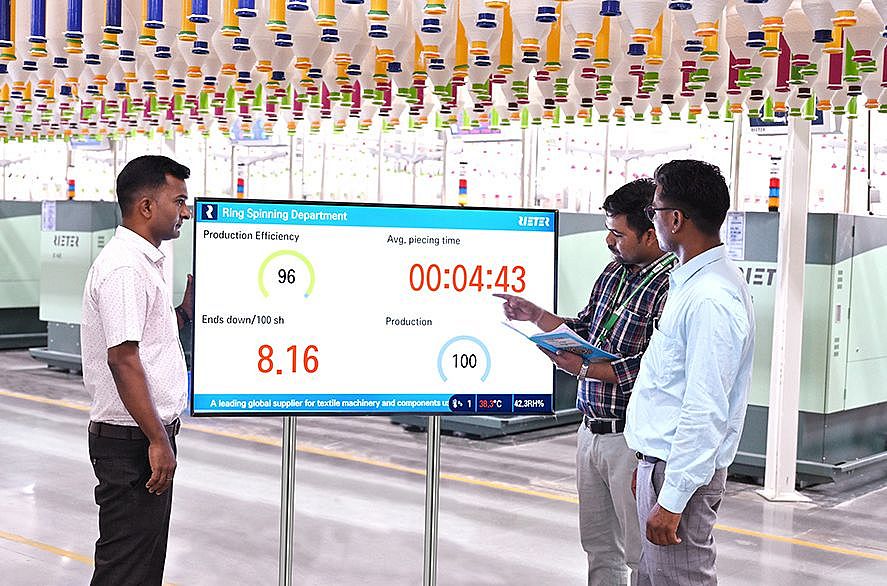The spinning mill is the heart of textile production, where raw fibers—whether natural, like cotton, or synthetic—are meticulously converted into yarn. At the pivotal stage where a single fibre strand becomes three—roving, sliver, and yarn—the role of sensors is critical to guarantee quality, speed, and efficiency.
The Spinning Process: Where Fibre Becomes Three
Stages of Fibre Consolidation
- Blow Room & Carding: Fibres are cleaned, blended, and carded into a soft, cohesive web, then condensed into a sliver.
- Drawing & Roving: Several slivers are drawn together to enhance uniformity, then drafted and slightly twisted to produce roving.
- Spinning Frame: Roving is stretched and twisted on ring, rotor, or air-jet spinning machines to create finished yarn.
At every stage, the precision and quality of the process are monitored using an array of innovative sensors.
Types of Sensors Used in Spinning Mills
1. Yarn Break Detectors
Function: Instantly detect breakages in the yarn, thereby reducing downtime and minimizing waste.
Example Providers:
- KJTDQ (Nanjing KJT Electric Co., Ltd.): Capacitor yarn break detectors and photoelectric yarn break detectors, suitable for winding, spinning, and synthetic fiber deformation.
- Quanzhou Jingzhun Machine Co., Ltd.: Yarn Break Sensor designed for rapid detection and minimal maintenance; widely used in the Chinese textile industry.
2. Optical and Capacitive Sensors
Function: Monitor the presence, movement, and quality of fibers and yarns using changes in light or electrical fields.
Applications:
- Detecting yarn stagnation or breakage.
- Measuring yarn thickness and uniformity.
Example Providers:
- Loepfe Brothers Ltd.: YarnMaster® PRISMA (dual measurement: capacitive and optical), P4-Sensor (4th Generation) for high-precision fault detection.
- Uster Technologies: Quantum 4.0 Smart Duo, combining capacitive and optical sensors for advanced yarn quality clearing.
3. Magnetic and Inductive Sensors
Function: Track the rotational speed of components such as travelers and spindles; detect metallic contamination.
Example Providers:
- Sensor Partners: Magnetic field sensors for monitoring traveler rotation in ring frames, critical for ensuring yarn continuity.
- Katlax Enterprises Pvt Ltd.: Multiple sensor solutions, including inductive proximity sensors designed for textile machinery.
4. Color and Structure Sensors
Function: Verify color, pattern, and fabric texture accuracy for quality assurance.
Example Providers:
- Sensor Instruments (Sensor Partners): Hybrid sensors (e.g., COAST) capable of measuring color and structure in textiles, distinguishing front/back surfaces, and maintaining homogeneity in materials.
5. IoT-Enabled Environmental Sensors
Function: Monitor ambient parameters such as temperature, humidity, and air quality to optimize conditions for fibre processing.
Example Providers:
- Rieter: ESSENTIALmonitor module for real-time production and environmental oversight, optimizing machine operation and reducing waste.
- IoT Sensor Platforms: Various industry vendors offer sensor nodes to measure key environmental factors, integrating real-time data for process control.
Advanced Technologies and Innovations
Digital Yarn Quality Monitoring
- Online Spindle Monitoring: Each spinning position is continuously tracked by sensors to promptly flag any production issues, allowing more precise interventions and less off-quality yarn.
- Rieter Digital Spinning Suite (ESSENTIALmonitor): Monitors each ring and compact spinning machine’s performance, identifies stop events, and tracks productivity—raising output and reducing manpower by up to 10%.
Dual Measurement Sensor Technology
- Uster Quantum 4.0: Utilizes both capacitive and optical methods in tandem (Smart Duo). Features “Cross Clearing” to eliminate hidden faults, and includes options for blend mix-up detection and polypropylene contamination monitoring.
- Loepfe YarnMaster® PRISMA: Combines optical, capacitive, and RGB-F sensor channels for detecting yarn irregularities, foreign matter, and color variations simultaneously.
Optical Fibre-Based Sensors
- Integration in Automated Weaving: Optical fibers incorporated in textiles and machinery for higher data throughput and for real-time structural monitoring. Can be adapted for in-process yarn monitoring for applications such as wearables and e-textiles.
AI and IoT in Spinning
- Artificial Intelligence: Recent developments use AI and machine learning to predict maintenance needs, track process efficiency, and optimize machine parameters—ensuring fewer stoppages and higher consistency.
- IoT Sensors and Cloud Analytics: Real-time data collection and analytic processing enable mill-wide optimization and predictive maintenance, drastically reducing the risk of operational downtime.
Leading Sensor Providers and Their Products
Impact and Benefits of Sensor Technology
1. Real-Time Fault Detection:
- Sensors immediately notify operators of yarn breaks, end-outs, or sliver misfeeds—preventing large-scale defects and waste.
- Improved efficiency: Shift supervisors address problems swiftly, ensuring continuous high-quality production.
2. Enhanced Quality Assurance:
- Advanced clearing systems with dual sensors detect even minor flaws—such as hard-to-see fluff or blend mix-ups—ensuring consistent yarn quality.
- Color and structure sensors keep shade and surface uniformity within specification, vital for downstream processes.
3. Predictive Maintenance and Reduced Downtime:
- IoT-enabled sensors and AI analytics predict wear and tear, minimizing unscheduled stoppages and optimizing maintenance cycles.
4. Labour and Energy Savings:
- Automated real-time monitoring reduces the need for manual patrols and interventions, cutting labor costs and saving energy by preventing inefficient operation periods.
Conclusion
Sensors have brought a revolution to spinning mills, transforming how fibre is processed into yarn. With innovations like dual measurement sensors, IoT-enabled machine monitoring, and AI-driven quality and efficiency control, the modern spinning mill is a hub of precision. Providers like KJTDQ, Uster Technologies, Loepfe, Sensor Partners, and Rieter offer solutions that push the boundaries of what’s possible, ensuring that every strand of yarn meets the textile industry’s highest standards. As technology continues to advance, spinning mills using these latest sensor technologies are poised to thrive in the fast-changing global textile market.
